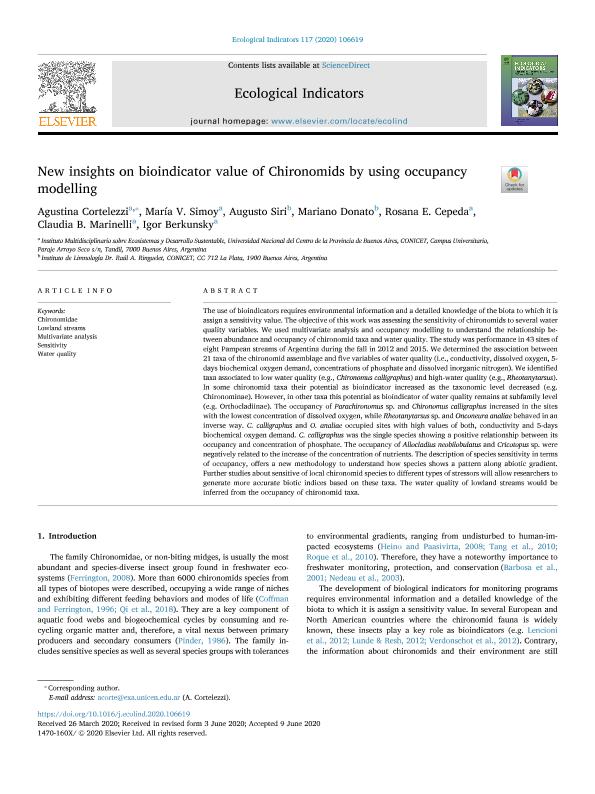Artículo
New insights on bioindicator value of Chironomids by using occupancy modelling
Cortelezzi, Agustina ; Simoy, Maria Veronica
; Simoy, Maria Veronica ; Siri, Augusto
; Siri, Augusto ; Donato, Mariano Humberto
; Donato, Mariano Humberto ; Cepeda, Rosana Esther; Marinelli, Claudia Beatriz; Berkunsky, Igor
; Cepeda, Rosana Esther; Marinelli, Claudia Beatriz; Berkunsky, Igor
 ; Simoy, Maria Veronica
; Simoy, Maria Veronica ; Siri, Augusto
; Siri, Augusto ; Donato, Mariano Humberto
; Donato, Mariano Humberto ; Cepeda, Rosana Esther; Marinelli, Claudia Beatriz; Berkunsky, Igor
; Cepeda, Rosana Esther; Marinelli, Claudia Beatriz; Berkunsky, Igor
Fecha de publicación:
10/2020
Editorial:
Elsevier Science
Revista:
Ecological Indicators
ISSN:
1470-160X
Idioma:
Inglés
Tipo de recurso:
Artículo publicado
Clasificación temática:
Resumen
The use of bioindicators requires environmental information and a detailed knowledge of the biota to which it is assign a sensitivity value. The objective of this work was assessing the sensitivity of chironomids to several water quality variables. We used multivariate analysis and occupancy modelling to understand the relationship between abundance and occupancy of chironomid taxa and water quality. The study was performance in 43 sites of eight Pampean streams of Argentina during the fall in 2012 and 2015. We determined the association between 21 taxa of the chironomid assemblage and five variables of water quality (i.e., conductivity, dissolved oxygen, 5-days biochemical oxygen demand, concentrations of phosphate and dissolved inorganic nitrogen). We identified taxa associated to low water quality (e.g., Chironomus calligraphus) and high-water quality (e.g., Rheotanytarsus). In some chironomid taxa their potential as bioindicator increased as the taxonomic level decreased (e.g. Chironominae). However, in other taxa this potential as bioindicator of water quality remains at subfamily level (e.g. Orthocladiinae). The occupancy of Parachironomus sp. and Chironomus calligraphus increased in the sites with the lowest concentration of dissolved oxygen, while Rheotanytarsus sp. and Onconeura analiae behaved in an inverse way. C. calligraphus and O. analiae occupied sites with high values of both, conductivity and 5-days biochemical oxygen demand. C. calligraphus was the single species showing a positive relationship between its occupancy and concentration of phosphate. The occupancy of Allocladius neobilobulatus and Cricotopus sp. were negatively related to the increase of the concentration of nutrients. The description of species sensitivity in terms of occupancy, offers a new methodology to understand how species shows a pattern along abiotic gradient. Further studies about sensitive of local chironomid species to different types of stressors will allow researchers to generate more accurate biotic indices based on these taxa. The water quality of lowland streams would be inferred from the occupancy of chironomid taxa.
Palabras clave:
CHIRONOMIDAE
,
LOWLAND STREAMS
,
MULTIVARIATE ANALYSIS
,
SENSITIVITY
,
WATER QUALITY
Archivos asociados
Licencia
Identificadores
Colecciones
Articulos(CCT - TANDIL)
Articulos de CTRO CIENTIFICO TECNOLOGICO CONICET - TANDIL
Articulos de CTRO CIENTIFICO TECNOLOGICO CONICET - TANDIL
Articulos(ILPLA)
Articulos de INST.DE LIMNOLOGIA "DR. RAUL A. RINGUELET"
Articulos de INST.DE LIMNOLOGIA "DR. RAUL A. RINGUELET"
Citación
Cortelezzi, Agustina; Simoy, Maria Veronica; Siri, Augusto; Donato, Mariano Humberto; Cepeda, Rosana Esther; et al.; New insights on bioindicator value of Chironomids by using occupancy modelling; Elsevier Science; Ecological Indicators; 117; 10-2020; 1-8; 106619
Compartir
Altmétricas



